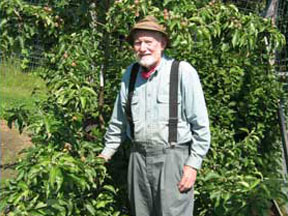#4) Walter Johnson: A pioneering public health doctor
 Click here to listen to the audio. Story length: 3:40 minutes. File size: 2.51 MB.
Click here to listen to the audio. Story length: 3:40 minutes. File size: 2.51 MB.  Narrator: Welcome to "History at Risk: Linking Alaskans to their Past". The history of bush Alaska has an unmatched frontier spirit, rooted in the people living closest to the land. The accounts can be full of commitment to community. As a young physician based in Bethel, Dr. Walter Johnson thought long and hard about health services in remote Alaskan villages. He believed better health services in the bush depended on training local people.
Narrator: Welcome to "History at Risk: Linking Alaskans to their Past". The history of bush Alaska has an unmatched frontier spirit, rooted in the people living closest to the land. The accounts can be full of commitment to community. As a young physician based in Bethel, Dr. Walter Johnson thought long and hard about health services in remote Alaskan villages. He believed better health services in the bush depended on training local people.Johnson: “It became obvious to me that there were never was going to be in all these places. In May of 1956, I sat down and wrote the letter proposing the training of local people. Well, I got a surprisingly favorable response because I didn’t think it was going to be a very popular idea.”
Narrator: Although Johnson’s idea stimulated interest, the concept of village-trained health aides was totally new and many in the health profession were skeptical. After his speciality residency in internal medicine in Boston, Dr. Johnson became chief of medicine at the Alaska Native Hospital in Anchorage. He saw an opportunity based on his experiences living and working in rural Alaska and his strong belief in the power of community.
Johnson: “Some of us who had lived in villages, we probably had a little different idea of the capacity of people. You know, it’s been my observation that the Native, or any of us who have lived close to nature, we develop a lot more acute ability I think to make observation. With so much language barrier, obviously they were in a much better position to get a history because they were bilingual. They were just perfectly capable of doing a basic physical exam.”
Narrator: Step by step Dr. Johnson worked to prove the concept could work. He never could have kept the program alive without the help and commitment from other doctors and community members, who were willing to learn and take on the difficult responsibility of health care in remote villages.
Johnson: “It was decided then that three of the outlying hospitals would call folks in and give them a couple weeks of training. Dr. Tom Harrison wrote that up. Now, they tell me there’s between 450-500 primary and secondary health aides and community health practitioners with a budget more like 17 million.”
Narrator: The program became essential for providing needed medical services in an efficient and practical manner. For the first time, village residents were able to obtain from local people they trusted the latest drugs and medications to treat serious illnesses.
Johnson: “The patient could see the remarkable results immediately. So we had magic bullets- all you needed was the person who could identify people who needed these drugs and give it to them. An advisory group of 5 or 6 people directed the writing of the first manual had only one doctor so they didn’t get bogged down in the medical jargon, and they didn’t get caught up in the mystique about the doctor supposed to play a God role.”
Narrator: Nearly 50 years after dr. Walter Johnson had the idea, the Community Health Aides Program continues to thrive delivering health care in bush Alaska. It has influenced recent efforts to develop similar systems for dental aides and behavioral health specialists.
Narrator: Funding was provided by the University of Alaska President's Special Projects Fund. From the University of Alaska Fairbanks Oral History Program, this is Bill Schneider.